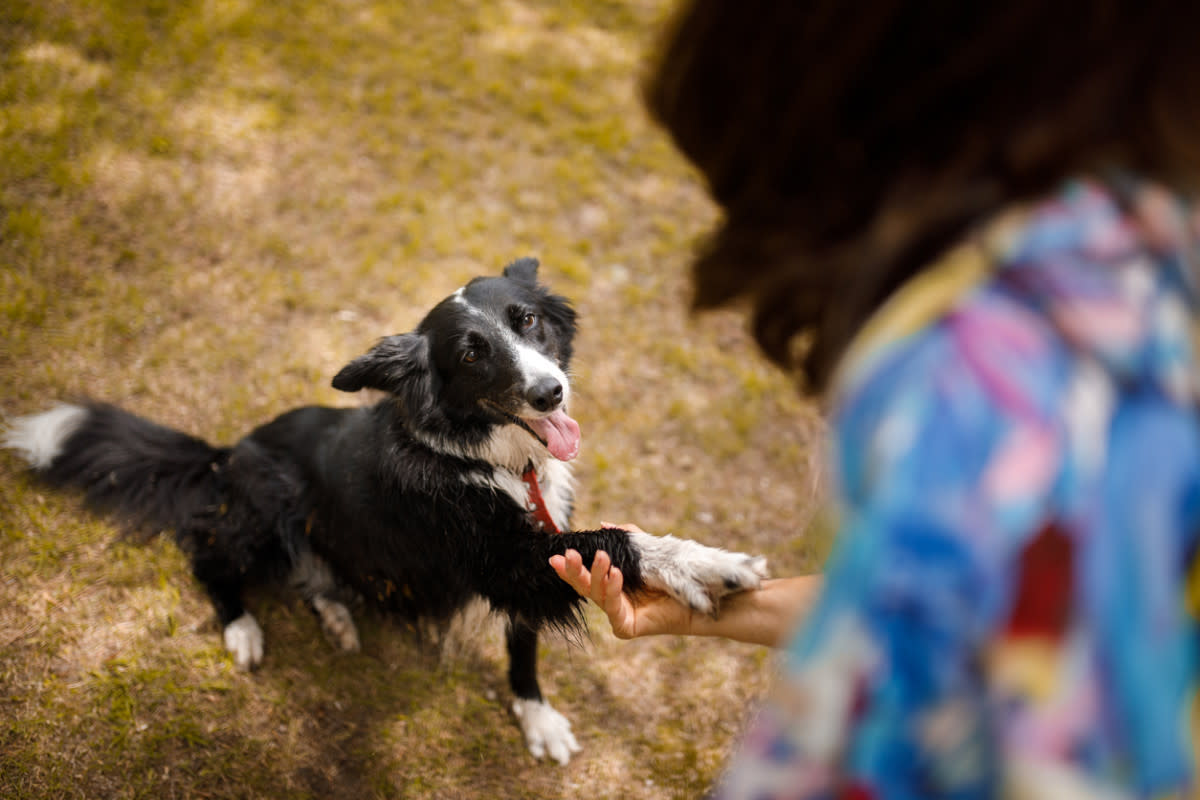'I'm a Dog Trainer and I Wish All Pet Parents Knew That This Is One Common Command Can Do More Harm Than Good'

Dog trainer teaching pet commands
Dog training is life-giving and life-saving for pups (and their human parents).
"There are useful behaviors we train our dogs that keep them safe, keep us sane and keep them happy too—from not ingesting objects to not bolting out the door," says Nicole Ellis, a certified professional dog trainer and pet lifestyle expert with Rover.
As with modern parenting, the best practices for dog training have evolved as experts have learned more. The TL;DR version: "By focusing on teaching and reinforcing useful...behaviors, you create a more effective, enjoyable and trusting relationship with your dog," Ellis says.
Not-so-useful behaviors can get in the way of bonding with our dog—but so can unhelpful commands. One dog training command tops Ellis' "no-fly" list. In fact, she says this common (and outdated) command can do way more harm than good.
Related: Veterinarian Exposes 3 Terms All Pet Parents Should Know When Buying Dog Food
The No. 1 Command a Dog Trainer Wishes Pet Parents Would Stop Using
You'll never catch Ellis doing the alpha roll.
"This command, often associated with outdated dominance-based training methods, involves forcibly rolling a dog onto its back and holding it down to assert dominance," Ellis says.
Wondering why someone would do that in the first place? Unfortunately, this still-commonplace command comes from outdated ideas about how dogs communicate.
"The theory behind this technique is to mimic the behavior of wolves in the wild, where a dominant wolf might pin a subordinate to establish hierarchy," Ellis explains. "Modern canine science has shown us that dogs do not operate strictly on a dominance hierarchy like wolves."
In short: "The alpha roll can have several negative consequences and should not be done," Ellis warns.
Why a Dog Trainer Doesn't Recommend the Alpha Roll (And What To Do Instead)
While you may have heard that you must be your dog's "pack leader," Ellis says pet parents don't want to be "feared." The goal is to be a sturdy, loving force in your furry friend's life, and the alpha roll will not do the trick.
"Forcing a dog into a submissive position can create significant fear and anxiety," Ellis says. "Rather than feeling secure, the dog may become more nervous and apprehensive around the handler, which can lead to more severe negative behaviors down the line."
Ellis adds that the alpha roll also breaks trust—a key cog for effective training and a positive relationship.
"Training methods based on trust, respect and positive reinforcement are more effective and humane, creating a more balanced, emotionally stable and trusting bond while achieving the goal out of respect vs. fear," Ellis says.
Related: Can Dogs Eat Cashews? Here's What Vets Say
5 Pro Tips on Dog Training
1. Don't: Be so hard on your dog
Yes, you want your dog to comply with your commands. However, some tactics are right up there with the outdated alpha roll in Ellis' book.
"You want to avoid overuse of commands, physical force, repeating commands and behavior terms, reading the dog's body language and asking something when they are not prepared or set up properly, inconsistency and not recognizing or rewarding small progress," Ellis says.
Related: Is Your Dog *Truly* Happy? Pet Behaviorists Share 6 Sneaky Signs to Look For
2. Do: Set your dog up for success
Putting your dog in a position to succeed benefits both of you.
"Set your dog up so that they will do what you’re trying to teach them or want," Ellis says.
Often, this means going slow and celebrating little wins.
"When asking a dog to stay, you may start with five or 10-second stays from close up," Ellis suggests.
As the dog consistently nails this command, you might progress to longer stays from further away.
Speaking of consistency: Use the same commands for desired behavior (such as "sit").
"Dogs learn best when they understand what is expected of them, and consistency helps reinforce this understanding," Ellis says.
3. Don't: Punish the dog
You might get frustrated if a dog gets a command "wrong" or even regresses in training. However, punishment is not the answer.
"Punishing a dog for not following a command can create fear and anxiety," Ellis says.
She invites pet parents to think about why the pet is having trouble following the desired behavior. You might ask yourself:
Do they not know it well enough?
Is it too difficult for them?
Are they in a situation where they may be nervous or fearful?
"Looking at how we can set the dog up for success, potentially a different calmer familiar environment or making the desired behavior easier to set them up for success," Ellis says.
4. Do: Reward the dog
Instead of punishing undesired behaviors, Ellis recommends highlighting good ones.
"Focus on positive reinforcement by rewarding good behavior with treats, praise or play," Ellis says.
Outside of designated training sessions, you can think of ways to reward good behavior in real life. For instance, say your dog has a habit of jumping on guests at the door. Think about what you'd prefer.
"Instead of getting mad and yelling no, ask for what you want and be ready to [reward] it, such as sit when someone enters," Ellis says.
5. Do: Make it fun
Dog training is like school for pups. Maybe school wasn't your jam growing up, but you and your dog can 100% look forward to the times when class is in session.
"Limit training sessions to five to 10 minutes, especially for young dogs," Ellis says. "Short, engaging, fun training sessions help keep your dog focused, prevent boredom or frustration and encourage them to want to train again."
Next: What Your Dog's Favorite Toy Reveals About Its Personality, According to a Vet
Expert Source
Nicole Ellis, a certified professional dog trainer and pet lifestyle expert with Rover

 Yahoo Lifestyle
Yahoo Lifestyle 
